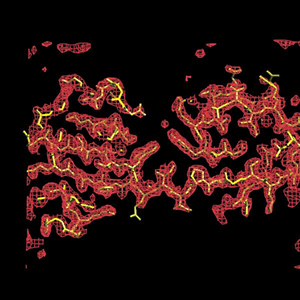
|
| SOLVE/RESOLVE electron-density map and auto-built atomic model for initiation factor 5a at a resolution of 2.1A. Multiwavelength diffraction data courtesy of Tom Peat; refinement with Garib Murshudov's refmac5; graphics drawn with Alwyn Jones' O |
RESOLVE is a program that improves electron density maps.
RESOLVE uses a statistical approach to combine experimental X-ray diffraction information with knowledge about the expected characteristics of an electron density map of a macromolecule.
You can run RESOLVE to improve your maps right after using SOLVE or another program to solve your structure.
Version 2.02 and higher of RESOLVE will build a model of your structure automatically. Version 2.03 and higher can be used for iterative model-building and refinement.
RESOLVE uses a new mathematical formulation to directly maximize the total probability of the phases. Most other approaches rely on phase recombination where the optimal statistical weighting of experimental and modified phases is not known.
Prime-and-switch phasing primes density modification with biased model phases, then switches entirely to an independent source of phase information (the probability of the map) to remove the model bias. Prime-and-switch phasing can give excellent unbiased maps even for crystals with very low solvent content (provided that the biased model did have substantial correct phase information!)
In addition to prime-and-switch phasing, version 2.0 of RESOLVE can find non-crystallographic symmetry in your heavy-atom sites and apply it automatically. Version 2.02 and higher can build a model for you as well. Versions 2.05 and higher can identify local patterns and use them to improve your phases. Versions 2.06 and higher can carry out iterative pattern id, fragment id, and model-building. RESOLVE versions 2.08 and higher can carry out automated ligand fitting as well.
The mathematics behind RESOLVE and examples of its use are described in the article "Maximum likelihood density modification," appearing in Acta Cryst. D56, 965---972 (2000).